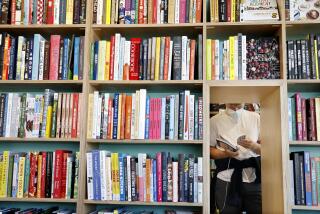Low Costs Lure Publishers Overseas
- Share via
American publishers of illustrated books appear to be going the same way American buyers of cars have gone in the past decade. Overseas.
“The element of craftsmanship is not part of the American psychology,” said Andrew Stewart, president of Stewart, Tabori and Chang of New York, a publisher of high quality, illustrated and photographic books.
“Yes, there are good firms here, such as Acme in Boston, but the cost is twice as much as overseas,” Stewart said.
“Prices are definitely competitive in the Far East and elsewhere, particularly in four-color work,” said Sam Last, vice president for production at Bantam Books.
“It’s not just prices, it’s quality. Book production here is boring,” said Joe Scrocco, who is production vice president at The Unicorn Publishing House, based in Parsippany, N.J. The company publishes mainly children’s books and illustrated books.
The three men said they feel it is worth a publisher’s while to look overseas for production of books including color, photography and illustrations. But it is not to a publisher’s advantage if the product is all text, such as fiction.
“You can get quick reprints here. You don’t need the same quality as you would for art or photography books and there’s the shipping time consideration,” said Stewart, who was president of Harry N. Abrams Inc. before he co-founded Stewart, Tabori and Chang.
One of this country’s largest book manufacturers is R. R. Donnelly and Sons. The company’s senior vice president for Eastern sales, Jerry Butler, countered some of the publishers’ criticisms.
“I disagree that craftsmanship has gone,” he said. “Apprentice programs still exist and have a place in manufacturing, and, I mean throughout the industry, not just at Donnelly. The employees go through the program to become journeymen and then work at their crafts.
“We also have electronic assistance now, innovative methods such as electronic eyes that watch quality. If you mean by craftsmanship that there is less hands-on work, yes, there is less because electronic methods are more competitive,” Butler said.
For many publishers, the manufacturing provision clause in the U.S. Copyright Act also is a major consideration. The clause says that if a book with less than 50% visual art content is manufactured overseas, it loses its U.S. copyright protection.
That clause protects U.S. book manufacturers but it expires July 1, 1986, unless renewed by the President. If it is not renewed, American book manufacturers face stiff competition from European and Asian colleagues.
Added Feature Costs
“One problem in the United States,” Unicorn’s Scrocco, said, “is that every feature you want added costs more. That’s not so in Korea. Another is that with high-volume production here, you are talking about using web printing instead of sheet printing.
“In web printing you use a single roll of paper and the entire book is run off at once and you can run into problems such as paper stretching, which means you might get ghosts in your picture. And if you’re standing there watching and see a color you don’t like, you’re afraid to stop the presses because you’re charged for paper wastage,” Scrocco said.
“With sheet printing, it’s slower because individual sheets of paper are fed in and pages are printed at once instead of a whole book. But the cost is too high for high-volume printing,” he said.
Creative Graphics International Inc. of New York City represents overseas book manufacturers. Through Creative Graphics, Unicorn has dealt with Samwah of Seoul, Korea.
Creative Graphics’s chief is Yoh Jinno, 34, who described the difference in cost.
“For a 9”by 9” paperback, 160 pages of which 150 pages are four-color and 10 are black and white, using sheet fed press, Smyth sewn (binding), 10,000 copies: In the United States it would cost $73,000; in Japan, $53,000 plus six cents per pound import duty; in Korea $38,500 and no duty to pay,” Jinno said.
More to Read
Sign up for our Book Club newsletter
Get the latest news, events and more from the Los Angeles Times Book Club, and help us get L.A. reading and talking.
You may occasionally receive promotional content from the Los Angeles Times.










